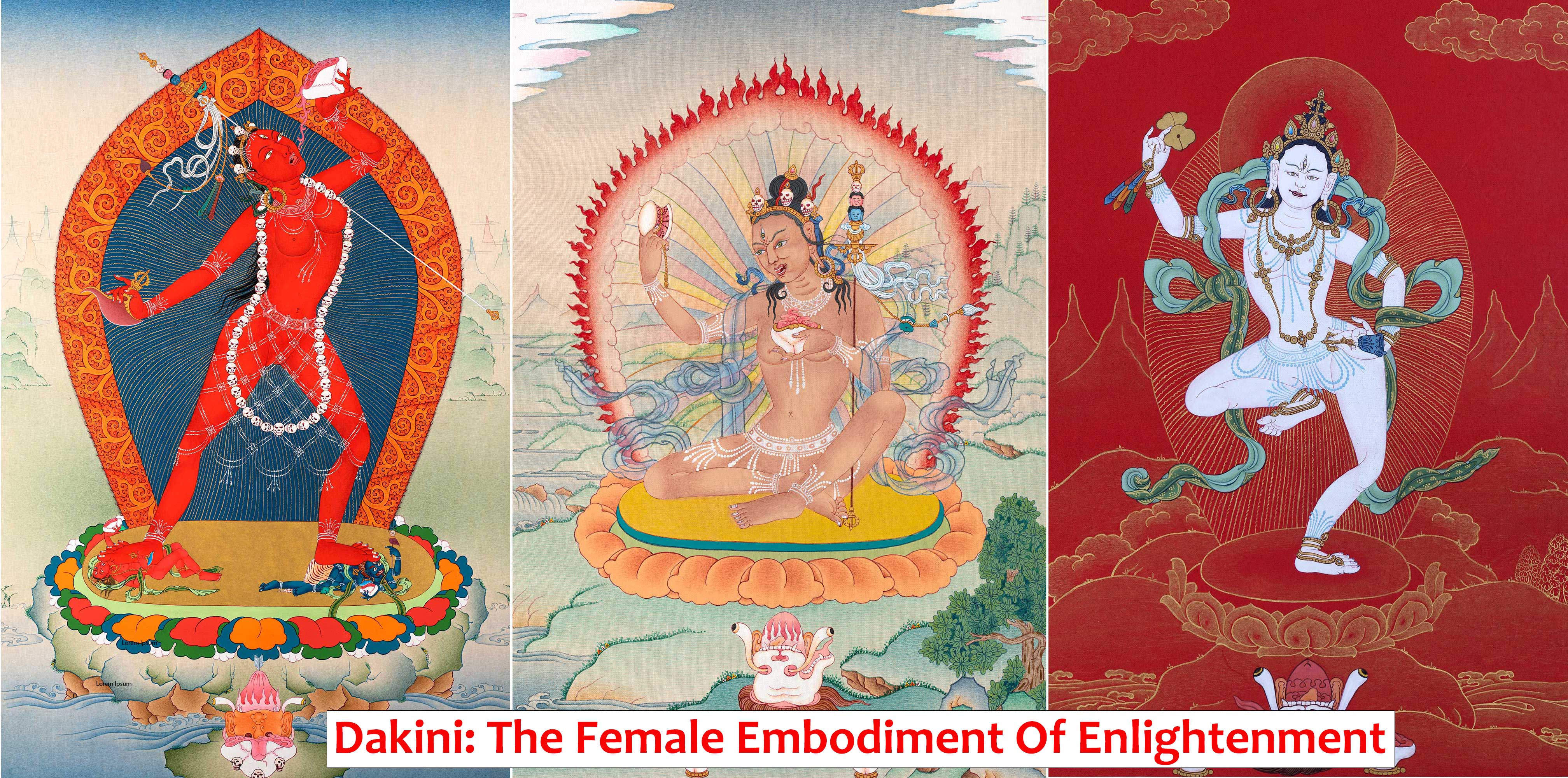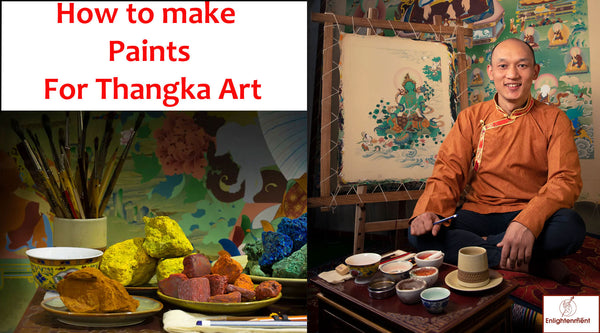What is a Dakini?
'Dakini' in Sanskrit and 'Khandro/ Khandroma' in Tibetan is the most revered manifestation of the feminine principle in Tibetan Buddhism. Those terms translate to 'sky dweller' or 'sky dancer.' They represent both humanity and divinity in the feminine form. Dakini, in simple words, is the female embodiment of enlightenment.
Dakinis are connected to the revelation of the 'Anuttara Yoga Tantras' or Higher Tantras, which stand for the path of change, as they are related to energy in all its manifestations. Here, the energy of poisonous emotions, or kleshas, is changed into the radiant energy of enlightened consciousness, or gnosis (jnana), which produces rigpa (non-dual awareness).
Dakini is mentioned in several Buddhist, Tantric, Hindu, and other myths. In Hinduism, Dakini took the shape of Kali and is revered as the Deity who consumes human flesh. Dakini was depicted in numerous ways in the Vajrayana formulation of the Three Jewels, also known as the Vajrayana formulation of Three Jewels. They are portrayed as a sort of spiritual force.
Dakinis can manifest in various ways depending on the situation; when appropriate, she can be fierce and intense or lighthearted and caring. She could be a human guru or a vajra master who shares Vajrayana teachings with her followers and enters into Samaya pacts with them.
The knowledge Dakini may be a yidam, a meditational deity; female deity yogas like Vajrayogini are ordinary in Tibetan Buddhism, or she may be a protector; the wisdom Dakinis have specific authority over and a duty to safeguard the integrity of oral teachings.
Origin Of Buddha Dakini
The devotion towards Dakini began between the 10th and 12th centuries in India. Vajrayogini appears as his yab-yum partner in the Chakrasamvara sadhana, from where it developed into a stand-alone practice of anuttarayoga tantra. Dakinis first appeared in Hindu art and literature about the same time as harsh and malicious spirits. Dakinis only became profoundly complex archetypes of liberating power inside Buddhist tantra.
The Dakini tradition was brought from India to Tibet, along with several Sanskrit Buddhist texts translated into Tibetan. As a result, Tibetan Buddhism is now the religion that Dakinis are most strongly associated with.
Tradition has it that a Dakini gifted him a black hat when Rangjung Dorje (1284-1339), the third Karmapa, was just three years old. The Black Crown was used as the logo for the earliest Tibetan lineage to practice reincarnation. Additionally, Dakini can be seen in Japanese Shingon Buddhism, where foxes are affiliated. Foxes can assume the shape of human women and are said to possess various magical abilities in Japanese legend.
Many lamas have said that women make superior practitioners because they can dive into meditation much more quickly than males. This is because many males are afraid of dropping their intellect, especially monks who have been studying for a long time. Suddenly letting that go and being naked in the meditation experience is frightening for them, whereas women seem to be able to manage it naturally. To me, the unique female quality (which, of course, many men have as well) is, first of all, a sharpness, a clarity," says Tenzin Palmo, who has vowed to attain enlightenment in a female body. "It cuts through—especially intellectual ossification. It . . . gets to the point. To me, the Dakini principle stands for the intuitive force. Women get it in a flash—they're not interested in an intellectual discussion which they normally find dry and cold with a minimum appeal."
-Western Num Jetsunma Tenzin Palmo
Classification of Dakini
Dakinis can either be enlightened or not. A "worldly" Dakini is a one who has not attained enlightenment. A worldly Dakini can appear as a trickster since she is still bound up in the wheel of samsara. Most of the time, when we discuss Dakinis, we are referring to wise or enlightened Dakinis.
Vajrayana Dakinis can be recognized in numerous ways and serve a variety of duties, although they are frequently divided into four main classes.
- The Secret Class (Prajanamaramita)
The Dakini represents the subtlest mental condition profoundly experienced in the greatest tantric yoga. They exist at the most ethereal level as the guardian of the enlightened state.
- The Inner Class (Mandala)
The Inner class refers to the yidam or meditational Deity representing the practitioner's most fundamental nature. They are the fully-enlightened Buddha who helps practitioner recognize their Buddhahood.
- The Outer Class (Physical Form Dakini)
As self-other dualities dissolve, the outer Dakini appears as a physical body, which might be the practitioner's physical body after realizing he is her. They can attain this only after the completion of Stage Tantra practices. For instance, the Six Yogas of Naropa work with the subtle winds of the subtle body in the sense that the practitioner's body is compatible with an enlightened mind.
- The Outer-Outer Class (Human Form)
This represents a Dakini in a human, for that may be a teacher, instructor, or yogini, a karma mudra, or consort of a yogi or mahasiddha.
Dakini can be classified according to the Trikaya (three bodies of a Buddha)
- The Dharmakaya Dakini,
Samantabhadri represents the Dharmadhatu, where all phenomena appear.
- The Sambhogakaya Dakinis
Yidams used as meditational deities for tantric practice.
- The Nirmanakaya Dakinis
Human women born with exceptional potentialities; realized yogini, the consorts of the gurus, or even all women in general as they may be classified into the Five Buddha Families.
Iconography of Dakini

In iconographic portrayals, the Dakini is typically depicted as a youthful, bare woman dancing while wielding a curved knife (Kartika) in one hand and a skullcup (kapala) filled with blood or the elixir of life in the other. She might be holding a trident stick against her shoulder and be sporting a garland made of human skulls. She usually has untamed hair that hangs down her back and a wrathful expression on her face. She dances on top of a corpse to symbolize her ultimate victory over ego and ignorance.
Dakini in Hinduism
Although Dakinis are the guardians of the more profound mysteries of the self in Hindu tantra, through whom the secrets of inner change are disclosed, the name "Dakini" is frequently associated with negative connotations in Hinduism. There is a difference between words like Shakti, Yogini, Shakini, and Dakini, it is commonly confused in common parlance, and the concepts are used interchangeably. A devotee who desires siddhi, or abilities, such as yogis, frequently encounters obstacles from Dakini, Shakini, and other wrathful or semi-wrathful feminine entities. They must be defeated or conquered to achieve siddhi and turn into a Mahasiddha, or a real yogi, who has mastery over nature's components.
In Hindu scripture, several mantras and strotas are said to either ward off or provide protection against Dakini, Shakini, and other entities. Hanuman is the principal god in charge of the Dakini and other beings.
The Vichitra Veer Hanuman Stroram lists the evil entities under Hanuman's power, including Dakini, and is sung in honor of 'Vichitra Veer Hanuman,' a fierce avatar of Hanuman. There are other Hanuman mantras for controlling a Dakini, but 'Saptamukhi Hanuman Kawacha' and 'Panchamukhi Hanuman Kawacham' are two of the most well-known. Hindus also recited Devi Kavacham, a song in honor of Durga, and 'Sri Sudarshana Kawacha,' a Sanskrit shloka or kawacha named after Vishnu's weapon 'Sudarshana Chakra' and chanted in praise of him.
Dakini in Japanese Buddhism
The Kukai's introduction of tantric Buddhism to the Shingon school in the early 9th century is said to have brought the Dakini imagery to Japan. The shape resembles Dakinis found in Hindu iconography rather than those found in the Tantra of Tibetan Buddhism.
The Dakini image was combined with half-naked women and foxes during the Heian era, giving rise to the titles Dakini-ten (Dakini-deity), Shinkoō-bosatsu (Central Fox Queen-Bodhisattva), and Kiko-tennō (Queen).
During his enthronement ritual, the Japanese Emperor of the Middle Ages would recite in front of a figure of the fox Dakini-ten. The shogun and the emperor would show Dakini-ten respect whenever they came across it.
At the time, it was widely believed that stopping the practice of paying honors to Dakini-ten would result in the regime's downfall. Although Dakini-ten is considered a strong Buddhist divinity, medieval and current depictions of it in Japan are based on local kitsune mythology.
The fox imagery was used instead of the Indian jackal, according to a contemporary folk notion frequently recorded in Japanese publications about religion; however, the jackal is nowhere connected to Dakini. The Dakini ritual evolved into numerous spells known as Dakini-ten, Izuna, and Akiba in early modern times. If someone in their community thought they had been mistreated, they might go to a corrupt yamabushi who used black magic and ask him to imprison a kitsune and have it inhabit a third party.
The Dakini emphasize the significance and interaction between prajna and upaya. "Wisdom" and "skillful methods." They work best when combined because wisdom, or substantial understanding, enables one to make the optimal decision. In this way, Dakini is comparable to Shakti in Hinduism and Sophia in Gnostic Christianity.
Some claim that practices that open the Muladhara (root chakra), the base of your subtle body, can be used to access the power of the Dakini. Hatha yoga poses like Pavanamuktanasana and Malasana are examples of such practices.



3 comments
Erica
Wow 🤯 interesting discovery of my Human existence since 1985. The Buddhist Musulman Hinduism Confusion are not oppressed by Satanist of Islamic and Catholic Churches of Eglise de Saint de Belgique qui porte Le foulard de Mormon 😂 Naseki religion Wana depuis 198
Erica
Wow 🤯 interesting discovery of my Human existence since 1985. The Buddhist Musulman Hinduism Confusion are not oppressed by Satanist of Islamic and Catholic Churches of Eglise de Saint de Belgique qui porte Le foulard de Mormon 😂 Naseki religion Wana depuis 198
Dra chenpo
Looking for a yab-yum that mit want to live in thee temple